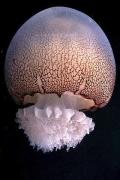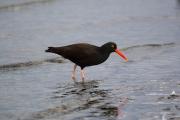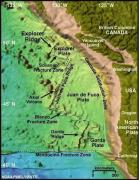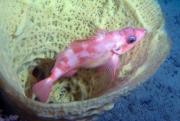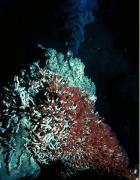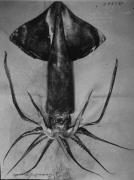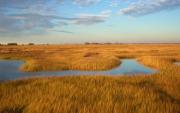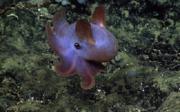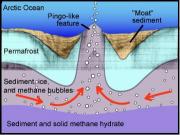Radio Program
Our regular Science and the SeaTM radio program presents marine science topics in an engaging two-minute story format. Our script writers gather ideas for the radio program from the University of Texas Marine Science Institute's researchers and from our very popular college class, Introduction to Oceanography, which we teach to hundreds of non-science majors at The University of Texas at Austin every year. Our radio programs are distributed at to commercial and public radio stations across the country.
A jelly ball sounds irresistible — until you realize the flavor isn’t grape, strawberry, or peach. That’s because “jelly ball” is a nickname for a type of jellyfish — the cannonball. It’s about as wide as a small pizza, and shaped like a mushroom. But even though it’s not that appetizing to most American palates, the cannonball has become a popular target for the fishing industry along the southeastern coast of the United States.
The American oystercatcher is a brawny shorebird. An adult stands about a foot-and-a-half tall and has a wingspan of up to three feet. Yet the oystercatcher is also among the most devoted of parents.
When most people talk about the “next big earthquake,” they usually mean a major temblor along the San Andreas Fault in southern California. But research over the last few decades suggests that the next big one might strike a little farther north — from northern California to southern British Columbia.
It’s a couple of thousand miles from the islands of the central Pacific Ocean to New Zealand. That’s an easy jaunt for modern transportation. For the first people to make the trip, though, it was a journey of weeks. And it might not have been possible at all without a temporary change in climate.
The people of Polynesia were master navigators. They used the stars, the weather, and even ripples on the ocean to find their way across long distances. That allowed them to colonize many islands in the central Pacific.
If your flower garden gets wiped out by a hard freeze, you can either plant new seeds and wait for them to grow, or you can plant whole flowers. They both work, but one of them gives you faster results.
Biologists are testing the “faster” method to restore sponge beds in the Florida Keys. They’re transplanting sponges from healthy beds to some that have been damaged by red tides and other causes. The hope is that the transplants will cut years off the time required to rebuild the beds.
A slice of the ocean floor off the coast of Washington State is like a scene from a fantasy land. Tapered spires climb high above the seabed, with some of them shooting boiling-hot water into the frigid depths. Tubeworms and other exotic life surround the spires. And small tremors jiggle the whole tableau several times a day.
They may not be able to leap tall buildings with a single bound, but some squid can escape danger by leaping into the sky and flying away. The flight doesn’t last very long, but it can put some distance between the squid and its predators.
Not all squid can accomplish this feat of aerial derring-do. The ability to fly is limited to a few species — mainly the Japanese flying squid, which is found along the rim of the northern Pacific Ocean. Most adults are no more than about a foot long.
In the 1960s comedy “Support Your Local Sheriff,” the mayor of a Western town apologizes to the newly hired sheriff when he hands him a badge that was dented by a bullet. When the sheriff speculates that the badge must have saved the life of the previous wearer, the mayor tells him that it probably would have if it hadn’t been for all those other bullets.
Recent research suggests that coastal wetlands face a similar problem. They could probably survive rising sea level just fine if it weren’t for all the other bullets fired by our planet’s changing climate.
The cutest little critter in the deep ocean just might be the dumbo octopus. It has large, rounded fins on its body that resemble the ears of Dumbo, Walt Disney’s animated elephant. And like the adorable little elephant, the dumbo octopus uses those big “ears” to get around.
Biologists have identified about 20 species of dumbos, which are also known by the scientific name Grimpoteuthis. They’re found all around the world. They’re not seen very often, though, because they live at depths of about two to two-and-a-half miles — deeper than any other octopus.
The ocean floor sometimes “burps.” In fact, according to some recent research, it burps a lot just off the eastern coast of the United States.
For two years, researchers used sonar to peer at the continental margin from Massachusetts down to North Carolina. That margin is where the shallow continental shelf gives way to the deep ocean.
The sonar revealed columns of bubbles streaming from 570 spots along the margin. The researchers haven’t sampled the gas in those bubbles, but it most likely consists of methane — the main ingredient in natural gas.

